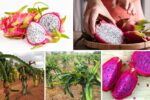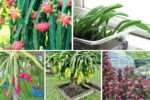When you think of cotton, you probably picture fluffy white bolls ready for harvest but did you know cotton fields can be breathtakingly beautiful too? From lush green foliage to striking blossoms in shades of white, pink, and even red, cotton plants add charm and visual interest to farmlands. Beyond their agricultural value, many cotton varieties are admired for their ornamental qualities, making fields look like living works of art. Let’s explore 10 cotton plants that don’t just produce they beautify.
1. Upland Cotton (Gossypium hirsutum)

The most widely grown cotton variety worldwide, Upland Cotton is as beautiful as it is productive. Known for its broad, deep green leaves and pale cream to pinkish flowers, this plant creates a soft, rolling landscape of color as it matures. The fluffy white bolls that follow look like clouds scattered across the fields. It thrives in warm, sunny climates and well-drained soil. Its simplicity and classic look make Upland Cotton a staple for farmers and a favorite for scenic fields.
2. Egyptian Cotton (Gossypium barbadense)

Famed for producing ultra-soft, luxurious fibers, Egyptian Cotton also offers visual appeal. The plants grow tall and elegant, with large, showy flowers that shift from pale yellow to deep pink as they mature. The lush foliage and elongated bolls add to its refined, ornamental presence. Often grown in warm, arid climates, this variety creates picturesque fields, especially during blooming season when flowers and cotton bolls intermingle. Its graceful growth habit and vibrant color changes make it one of the most beautiful cotton types to cultivate.
3. Sea Island Cotton

Sea Island Cotton is known for its silky, long-staple fibers, but it’s also a feast for the eyes. Native to coastal regions, this variety produces large, delicate flowers with buttery yellow petals that turn blush pink after pollination. Its glossy, dark green leaves create a lush backdrop for the soft, cloud-like bolls. Sea Island Cotton fields offer a stunning contrast between the deep foliage and bright white cotton, especially under a clear blue sky, making them a visual highlight in Southern coastal farms.
4. Brown Cotton (Gossypium hirsutum var. fuscum)

For a touch of rustic charm, Brown Cotton is a standout. Instead of traditional white bolls, this variety produces naturally brown fiber, ranging from soft cinnamon to deep chocolate hues. Before the bolls open, the plants showcase pale yellow flowers with a reddish center, adding extra visual interest. Brown Cotton fields create a warm, earthy canvas when the bolls burst open, perfect for artisan growers and heirloom farms. It’s not just a fiber source but a statement piece in any agricultural landscape.
5. Green Cotton (Gossypium hirsutum var. viridescens)

Another heirloom variety, Green Cotton brings an unexpected splash of color to the field. Its pale green bolls open to reveal soft, sage-tinted fiber, contrasting beautifully against dark green foliage. The flowers start pale yellow and develop pink accents as they age. Green Cotton fields offer a serene, naturalistic look, especially in organic or sustainable farms. Beyond its beauty, this cotton type is prized for its unique, naturally colored fiber often used in eco-friendly textiles.
6. Nankeen Cotton

Nankeen Cotton is an old-world variety producing a soft, golden-brown fiber. Its flowers are initially creamy white, turning pink after pollination, creating a dynamic color display across fields during the blooming season. The bolls split open to reveal fiber that glows warmly in the sunlight. Nankeen Cotton fields have an antique, pastoral charm, offering a glimpse into historic farming landscapes. It’s an excellent option for specialty growers who value both beauty and traditional agricultural heritage.
7. Tree Cotton (Gossypium arboreum)

Native to India and parts of Southeast Asia, Tree Cotton grows taller than most cotton plants, often reaching heights of up to 10 feet. It produces stunning, hibiscus-like flowers that start bright yellow and fade to deep purple. The bolls contain soft white or brownish fiber. When planted in large groups, Tree Cotton fields resemble wildflower meadows during the bloom, with tall plants swaying in the breeze. Its ornamental appeal and height make it a favorite for mixed-use or demonstration farms.
8. Peruvian Tanguis Cotton

Highly regarded for its resilience and silky fiber, Tanguis Cotton also enhances field aesthetics. Native to Peru, its plants feature broad leaves and produce creamy white flowers that shift to pink as they mature. The bolls burst open into soft, bright fiber clusters. Tanguis Cotton fields are particularly striking during harvest, with rich green plants crowned by brilliant white tufts. Its robust, upright growth creates uniform, tidy rows, offering both functionality and beauty to the landscape.
9. Pima Cotton

Closely related to Egyptian Cotton, Pima is famed for its exceptional softness and strength. In the field, it stands out with large, glossy leaves and beautiful, color-changing flowers that begin as pale yellow and transition to dark pink. The sizable, fluffy bolls add a dramatic contrast against the deep foliage. Pima Cotton fields are both orderly and colorful during the growing season, providing a scenic backdrop for agricultural tours, photo opportunities, or farm-to-fabric workshops.
10. Red-Leaf Cotton (Gossypium barbadense hybrid)

A rare but striking ornamental cotton, Red-Leaf Cotton sports deep burgundy to purple-tinted foliage, making it a visual highlight in any field. Its large, trumpet-shaped flowers are pale yellow, standing out dramatically against the dark leaves. The contrast becomes even more stunning when the fluffy white bolls emerge. Red-Leaf Cotton is often used in boutique farms, garden displays, and agricultural demonstrations due to its unique appearance. It’s proof that cotton can be both a valuable crop and an ornamental showpiece.





